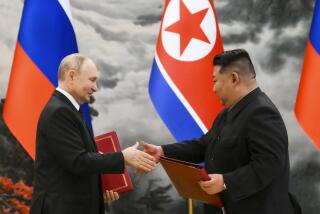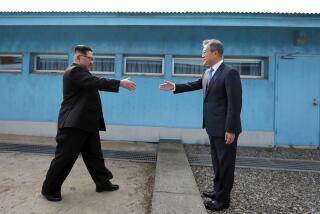THE TWO KOREAS: A Contemporary History. <i> By Don Oberdorfer</i> . <i> Addison-Wesley: 472 pp., $30</i>
A little more than three years ago, the United States nearly plunged into a war that could have killed an estimated 1 million people, including more than 100,000 American soldiers, and cost more than $100 billion (about double the cost of the Persian Gulf War). Yet this near-war, like so much else about Korea, is mostly unknown to the American people. “The Two Koreas,” Don Oberdorfer’s fine book covering the last quarter-century of Korean history, contains the only detailed account of the frightening 1994 crisis over North Korea’s nuclear program.
Based on inside information that Oberdorfer garnered from interviews conducted with key officials in Washington and around the world, his gripping narrative should chasten our leaders and inform our citizenry about the continuing perils and costs of America’s involvement with Korea, which began 52 years ago when American troops marched into Seoul amid the ashes of Imperial Japan’s defeat. But “The Two Koreas” does much more than that: At a time when frivolous sensationalism dominates the media, it illustrates the virtues of a life given to honest, independent and inquiring journalism.
Oberdorfer reported from Japan and Korea for many years, becoming the Northeast Asia bureau chief and then a White House correspondent for the Washington Post, until his recent appointment as distinguished journalist in residence at Johns Hopkins University. I first met Oberdorfer 20 years ago when I invited him to give a lecture at the university where I taught, offering him a measly $300 fee. (He happily agreed to do the lecture but said that as a journalist he could not accept more than “the equivalent of a Virginia ham.” I never forgot that remark and often wondered why scholars did not always have similar scruples.) The author of “Tet!” (a National Book Award finalist) and other books, Oberdorfer was one of a handful of reporters whom specialists could call on to learn something new, something different, something truly learned about the countries they studied.
In “The Two Koreas,” Oberdorfer has sought not just to sum up an admirable career but to write “contemporary history . . . only a few years after the events.” In this case, that means a detailed insider’s account of the period since President Nixon opened China, when then-Secretary of State Henry Kissinger arrived in Beijing in 1971 on a secret visit only to find then-Chinese Premier Chou En-lai also hosting (secretly) the North Korean leader Kim Il Sung. Oberdorfer excels at weaving together the characters and events of the period (often ones that he covered as a reporter) with more recent interviews with major participants in Washington, Seoul, Pyongyang, Beijing and Tokyo. He also pays more attention than usual to the work of scholars on Korea.
What results is not really the history of the two Koreas but of American relations with Korea in the last 25 years. Oberdorfer is often definitive on that subject, deploying information that even specialists do not know. He pens remarkably accurate portraits of a diverse group of people: South Korean presidents (all of whom he met except for the first, Syngman Rhee), the late and enigmatic Kim Il Sung, the best of American officials (like Philip Habib) and the worst (of whom there are several candidates capable of truly appalling behavior in our long relationship with Korea).
For example, when former President Jimmy Carter asked the newly elected Ronald Reagan to speak with the new strongman in Seoul (the now-jailed and disgraced Chun Doo Hwan) to spare the life of dissident Kim Dae Jung, Reagan stunned Carter by saying, “Mr. President, I’d like to have the power that Korean presidents have to draft dissenters.” Oberdorfer deploys new information about the stratagems by which the permanent national security bureaucracy (the CIA, the Defense Intelligence Agency and other elements in the Pentagon) shut down Carter’s plans to withdraw American troops from South Korea some time in 1978-79, beginning with drastically increased intelligence estimates of the size of the North Korean armed forces.
In presenting a fascinating episode during Carter’s visit to Seoul in June 1979, Oberdorfer describes Carter’s slow burn while South Korean President Park Chung Hee lectured him on why American troops could not be withdrawn, snapping his fingers for emphasis, followed by Carter’s taking Park aside for “a flinty private discussion of the imprisonment and intimidation of political dissidents.”
Assistant Secretary of State Richard Holbrooke, who was then assistant secretary for East Asian and Pacific affairs, called this encounter “terrible”; Oberdorfer recounts how Holbrooke and every other high official agreed with Park and not with their own president. Carter got into his limousine and accused his aides of conspiring against him. Secretary of State Cyrus Vance, Defense Secretary Harold Brown and U.S. Ambassador William Gleysteen spent what seemed like an eternity at the head of a long motorcade, trying to convince Carter that, whatever he thought about Park, American troops had to stay. And stay they have, right through the end of the Cold War and the collapse of the Soviet Union. “I have always suspected that the facts [about the North Korean buildup] were doctored by DIA [Defense Intelligence Agency] and others,” Carter told Oberdorfer recently, “but it was beyond the capability even of a president to prove this.”
Oberdorfer finds North Korea unique and fascinating, almost in spite of himself. He is highly critical of North Korea’s “Confucian communism,” but he cannot help but be candid and independent. He provides one of the best and most accurate portraits of Kim Il Sung--”an Oriental Talleyrand,” in the words of a former Soviet official who knew him well. Shrewd and intelligent, like many other Korean leaders he was also a stickler for detail: “I cannot rest easily unless I have the whole situation at my fingertips,” he said.
In the early 1990s, by this book’s account, Kim ran rings around American officials. His closely sheltered nuclear reactor was his ace in the hole and, according to Oberdorfer, he “played [the] card brilliantly.”
Meanwhile, Pyongyang’s intrepid negotiator in high-level talks with the United States, Kang Sok Ju, told his American counterparts that one of his favorite books was “Gone With the Wind.” “To their amazement, he quoted from it to prove the point,” the author writes.
“The Two Koreas” falls short now and then in its treatment of certain aspects of recent Korean history. The American military government (1945-48), for example, is not even mentioned in Oberdorfer’s brief discussion of how one Korea turned into two. Yet it was the crucible for much of the later history that he surveys. Much more should have been said about the decades-long popular struggle for democracy in South Korea. Oberdorfer’s interview method includes mostly elites and allows far too much room for these people to act as their own apologists. Gleysteen, for example, is allowed to whitewash his own behavior and that of many other influential Americans during the crisis of 1979-80, which began with Park’s assassination and ended with massive bloodletting in the southwestern city of Kwangju, the essential prelude to Chun’s coup d’etat. My criticism would be more severe if Oberdorfer was a historian. It may be that as a journalist he eschews interpretation and hopes that his facts will speak for themselves. For the most part in this book, they do.
The crisis in 1994, which lasted from mid-May to late June, is too detailed for treatment here. But Oberdorfer’s recapitulation, unavailable anywhere else, is must reading, and it will curl your hair. Once again Jimmy Carter gets high marks compared to the Korea know-it-alls inside the beltway; by flying off to Pyongyang in June 1994 and meeting with Kim II Sung, he did more than anyone else to avert the impending catastrophe.
Oberdorfer’s account also makes clear that it is time to reevaluate the half-century American troop presence in Korea. One of his sources estimates that, without that commitment, the United States could cut its military budget by one-quarter, saving $20 billion to $30 billion a year (about what the federal government spends for health research).
Far more important, the American people would get a choice about whether they want their sons and daughters chewed up in another Korean War. As things stand today, with 37,000 Americans still manning the ramparts of a little-known “family quarrel,” as Oberdorfer calls the conflict between North and South, that choice has already been made.
More to Read
Sign up for our Book Club newsletter
Get the latest news, events and more from the Los Angeles Times Book Club, and help us get L.A. reading and talking.
You may occasionally receive promotional content from the Los Angeles Times.









